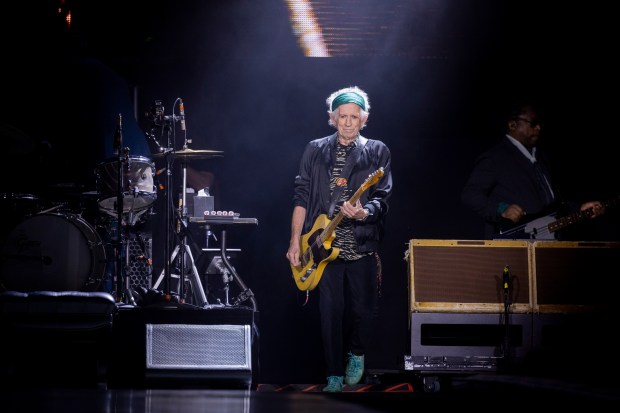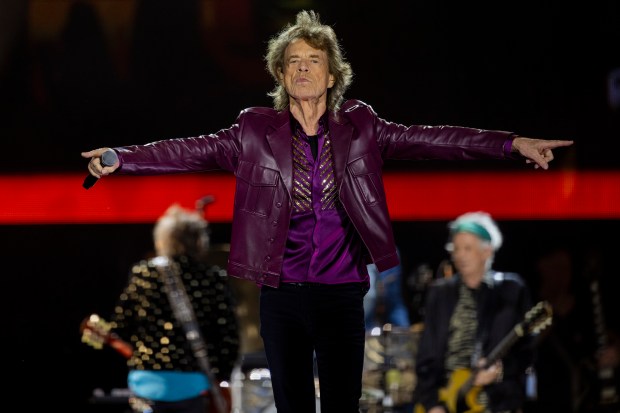Mick Jagger beat the braggadocio boasts of “Start Me Up” to the punch Thursday at a packed Soldier Field. The Rolling Stones vocalist was already riled up and running hot before the resonant chords of the recognizable anthem signaled the opening of the legendary band’s first of a two-night stand at the lakefront venue. (The group returns Sunday.)
For most of the next two hours, Jagger nearly single-handedly carried the concert. He defied the limitations often associated with his 80-year age and refused to mail in a single verse. Questions about the Stones’ predictability, purpose and joyfulness aside, the physically fit singer continues to take performance as seriously as anyone in the business. He nailed his deliveries, projected enthusiasm, embodied determination and gave a master class in the art of animated dance moves. AARP, the tour sponsor, couldn’t have dreamt up a better advertisement.
Playing the 40th Chicago concert of their career and the first local gig without their late drummer Charlie Watts (who died in 2021), the Stones frequently needed the boost. The impossible task of succeeding Watts fell to the talented Steve Jordan, whose collaborative relationship with guitarist Keith Richards stretches back to the Reagan era. In a possible nod to Watts’ famously keen fashion style, Jordan sported a smart suit and black sunglasses. He knew the parts inside-out, though his approach — slightly busier and heavier, with less swing, glide and refinement than the jazz-leaning Watts — altered the rhythmic structures in ways obvious to anyone with a history of seeing the band.
Still, as they say, the show must go on. Nearly 35 years after they mounted a comeback trek that prompted some critics to crack wise about their ages in the context of rock ‘n’ roll, the Rolling Stones keep on keepin’ on, in spite of internal issues, health setbacks and mortality. In the face of endless, cliched stories that lazily incorporate their song titles (“The Last Time,” “It’s Only Rock ‘n’ Roll (But I Like It)”). Their persistence — along with their ubiquitous classics and iconic tongue-and-lips logo — have made the Stones the most widely identifiable rock group in history.
In many ways, the Stones are as much a brand as a band, and one that apparently never goes out of style. Modeled by chic young adults, the vast array of apparel hawked on their website gives fashion houses a run for their money. While Taylor Swift inspires headlines about boosting local economies and altering countries’ inflation rates, the Stones remain a box-office juggernaut that regularly grosses upwards of $10 million per gig. This after creating the blueprint for stadium tours in the late ’80s.
Lineup alterations aside, little regarding the Stones has changed since they released their last great album (“Tattoo You”) in 1981. The primary differences today concern the environment in which the group operates. The concept of selling out no longer exists. Rock ‘n’ roll ceded its dominance to hip hop and pop decades ago. Standalone artists overtook groups in terms of star power. Consider: You don’t even need all the fingers on one hand to count how many bands formed since the dawn of the 21st century can fill a hockey arena for two shows.
Indeed, the sense that the imitable combination of sound, interplay and chemistry that transpired on the grand if somewhat minimalist Soldier Field stage might soon be difficult to come by seemed lost on no one — including the last three core Stones themselves and their supporting cast, particularly longtime keyboardist Chuck Leavell and Chicago native Darryl Jones, whose full-bodied bass lines provided a steadying element when other aspects wavered.
Sticking to the center of the stage, tufts of white-and-gray hair struggling to emerge beyond his trademark headband, Richards occasionally appeared reticent and noncommittal. The 80-year-old looked as if he’d slowed. He struck noticeably sour notes on “Start Me Up,” adopted a perfunctory stance during his vocal lead on a flat “Tell Me Straight” and required several songs to find his footing. Yet Richards’ personalized technique — he navigated by feeling, read what the material demanded and reacted accordingly, ignoring timing and placement conventions — corresponded to a manner of disciplined improvisation that can only be shaped over decades of experience.
When it sparked, his rapport with fellow guitarist Ron Wood gave diehards visions of a more youthful past and newer fans a reason to savor the moments when the duo locked into a groove and held tight. Jabbing and scraping their instruments’ strings, Richards and Wood juggled decay and distortion and communicated with scuffed tones, squawking riffs and sharp, twangy fills. The grittiest of their output doubled as rude interjections (“Little T&A”), R&B rejoinders (“Tumbling Dice”), clarion calls (“Jumpin’ Jack Flash”) and booze-soaked lures (“Honky Tonk Women”).
As expected, the Stones leveraged familiarity to their advantage. Along with one fan-selected song (a watered-down “She’s a Rainbow”) and one dusted-off gem (a reggae-tinted “Get Off of My Cloud”), four songs from their recent “Hackney Diamonds” LP cracked a setlist anchored by the same hits the group has featured for eons. Nothing released between 1981 and 2023 made the cut. Yes, people pay big bucks to hear favorites. But why not tackle one of the other seldom-played numbers (“Bite My Head Off,” “Fool to Cry,” “She’s So Cold”) that lost the popular vote? Or toss a couple of known albeit deeper tracks into the mix?
Instead, the energetic and attitudinal antidote to the pervasive politeness stemmed from Jagger. Adorned in black jeans, and modeling an assortment of jackets and shirts, the livewire singer justified the presence of both the stage’s short runway and extended wings. He strutted, waggled, pointed, shimmied, shuffled, summoned, pouted, preened and vogued. His petite hips turned on an imaginary swivel; his loose shoulders flirted with joint dislocation; his restless hands flapped as if trying to shake off a tingling numbness.
Save for the 15 minutes he went backstage and let Richards handle the microphone, Jagger alternated between the roles as singer, cheerleader, MC, jokester — he deemed the evening’s presidential debate “Viagarapalooza” — and storyteller. He touched on the band’s first trip to Chicago in 1964 and fortune at meeting its idols (Muddy Waters, Howlin’ Wolf, Chuck Berry) at Chess Records. He failed to mention that the studio sat about a mile from where he currently stood, or that the Stones recorded a batch of songs while there. Too bad the group didn’t play one of them as a full-circle tribute.

The closest the Rolling Stones got to musically acknowledging the city’s blues impact on their fare arrived during a tease of “Sweet Home Chicago” amid a harmonica-laden run-through of “Midnight Rambler.” The circa-1969 tune emerged as one of the few that hinted at its original menace. Another, a long-fuse reading of “Gimme Shelter,” also of ‘69 vintage, benefitted from the fiery participation and soulful blare of backup vocalist Chanel Haynes.
“War, children,” Jagger and Haynes sang, conscious of the ominous warnings that followed. “It’s just a shot away.” For the briefest instant, all the years and wrinkles melted away, and the Stones were again ragtag British dissidents spreading and sounding an urgent alarm amid an ever-tumultuous global climate. Godspeed.
Bob Gendron is a freelance critic.
Setlist from Soldier Field June 27:
“Start Me Up”
“Get Off of My Cloud”
“It’s Only Rock ’n’ Roll (But I Like It)”
“Angry”
“She’s a Rainbow”
“Wild Horses”
“Mess It Up”
“Tumbling Dice”
“You Can’t Always Get What You Want”
“Tell Me Straight”
“Little T&A”
“Happy”
“Sympathy for the Devil”
“Honky Tonk Women”
“Midnight Rambler”
“Gimme Shelter”
“Paint It Black”
“Jumpin’ Jack Flash”
Encore
“Sweet Sounds of Heaven”
“(I Can’t Get No) Satisfaction”



